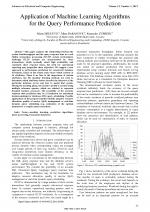| 3/2015 - 5 |
Application of Machine Learning Algorithms for the Query Performance PredictionMILICEVIC, M. |
| View the paper record and citations in |
| Click to see author's profile in |
| Download PDF |
Author keywords
machine learning, prediction algorithms, query processing, transaction databases
References keywords
learning(16), performance(13), data(13), prediction(12), machine(12), database(12), systems(10), query(10), workloads(7), francisco(7)
Blue keywords are present in both the references section and the paper title.
About this article
Date of Publication: 2015-08-31
Volume 15, Issue 3, Year 2015, On page(s): 33 - 44
ISSN: 1582-7445, e-ISSN: 1844-7600
Digital Object Identifier: 10.4316/AECE.2015.03005
Web of Science Accession Number: 000360171500005
SCOPUS ID: 84940732050
Abstract
This paper analyzes the relationship between the system load/throughput and the query response time in a real Online transaction processing (OLTP) system environment. Although OLTP systems are characterized by short transactions, which normally entail high availability and consistent short response times, the need for operational reporting may jeopardize these objectives. We suggest a new approach to performance prediction for concurrent database workloads, based on the system state vector which consists of 36 attributes. There is no bias to the importance of certain attributes, but the machine learning methods are used to determine which attributes better describe the behavior of the particular database server and how to model that system. During the learning phase, the system's profile is created using multiple reference queries, which are selected to represent frequent business processes. The possibility of the accurate response time prediction may be a foundation for automated decision-making for database (DB) query scheduling. Possible applications of the proposed method include adaptive resource allocation, quality of service (QoS) management or real-time dynamic query scheduling (e.g. estimation of the optimal moment for a complex query execution). |
| References | | | Cited By |
Web of Science® Times Cited: 3 [View]
View record in Web of Science® [View]
View Related Records® [View]
Updated today
SCOPUS® Times Cited: 4
View record in SCOPUS® [Free preview]
View citations in SCOPUS® [Free preview]
[1] Autonomic performance prediction framework for data warehouse queries using lazy learning approach, Raza, Basit, Aslam, Adeel, Sher, Asma, Malik, Ahmad Kamran, Faheem, Muhammad, Applied Soft Computing, ISSN 1568-4946, Issue , 2020.
Digital Object Identifier: 10.1016/j.asoc.2020.106216 [CrossRef]
[2] Yapay zeka tarafından kontrol edilen yeni bir termoelektrik CPU soğutma sistemi, UMUT, İlhan, AKAL, Dinçer, Gazi Üniversitesi Mühendislik Mimarlık Fakültesi Dergisi, ISSN 1300-1884, Issue 1, Volume 39, 2023.
Digital Object Identifier: 10.17341/gazimmfd.1150632 [CrossRef]
[3] Autonomic workload performance tuning in large-scale data repositories, Raza, Basit, Sher, Asma, Afzal, Sana, Malik, Ahmad Kamran, Anjum, Adeel, Kumar, Yogan Jaya, Faheem, Muhammad, Knowledge and Information Systems, ISSN 0219-1377, Issue 1, Volume 61, 2019.
Digital Object Identifier: 10.1007/s10115-018-1272-0 [CrossRef]
[4] Tifinagh Handwriting Character Recognition Using a CNN Provided as a Web Service, Kadri, Ouahab, Benyahia, Abderrezak, Abdelhadi, Adel, International Journal of Cloud Applications and Computing, ISSN 2156-1834, Issue 1, Volume 12, 2022.
Digital Object Identifier: 10.4018/IJCAC.297093 [CrossRef]
Disclaimer: All information displayed above was retrieved by using remote connections to respective databases. For the best user experience, we update all data by using background processes, and use caches in order to reduce the load on the servers we retrieve the information from. As we have no control on the availability of the database servers and sometimes the Internet connectivity may be affected, we do not guarantee the information is correct or complete. For the most accurate data, please always consult the database sites directly. Some external links require authentication or an institutional subscription.
Web of Science® is a registered trademark of Clarivate Analytics, Scopus® is a registered trademark of Elsevier B.V., other product names, company names, brand names, trademarks and logos are the property of their respective owners.
Faculty of Electrical Engineering and Computer Science
Stefan cel Mare University of Suceava, Romania
All rights reserved: Advances in Electrical and Computer Engineering is a registered trademark of the Stefan cel Mare University of Suceava. No part of this publication may be reproduced, stored in a retrieval system, photocopied, recorded or archived, without the written permission from the Editor. When authors submit their papers for publication, they agree that the copyright for their article be transferred to the Faculty of Electrical Engineering and Computer Science, Stefan cel Mare University of Suceava, Romania, if and only if the articles are accepted for publication. The copyright covers the exclusive rights to reproduce and distribute the article, including reprints and translations.
Permission for other use: The copyright owner's consent does not extend to copying for general distribution, for promotion, for creating new works, or for resale. Specific written permission must be obtained from the Editor for such copying. Direct linking to files hosted on this website is strictly prohibited.
Disclaimer: Whilst every effort is made by the publishers and editorial board to see that no inaccurate or misleading data, opinions or statements appear in this journal, they wish to make it clear that all information and opinions formulated in the articles, as well as linguistic accuracy, are the sole responsibility of the author.





